What better morning than oatmeal, juice, coffee, whatever CDs strike my fancy, and a pile of books (Bellow, Baudelaire, Montaigne) on my bed, while the clouds gloom it up outside? And playing a phrase of Schubert over and over, for kicks, and running to the piano, trying to figure out the harmonies in Rufus Wainwright. I know these hours (the first, “most productive” hours of the day) are sinful idleness, an egghead’s Eden, and only marginally my profession; I know that my own pleasure is unreasonable but it exists. Afterwards I do not feel a stomachache as I do after nachos, popcorn, etc. How can I harvest my own positive energy at these times for the world’s greater good? I must be plugged in there somewhere.
I am very insecure about what I’m about to do: “prove” a puppy love. Today, and yesterday, and the day before, I am truly loving Memphis Skyline from Rufus Wainwright’s album, Want Two. I am worried this blog contains nothing but love letters to pieces whose right to be loved is already beyond dispute (though these pieces are, therefore, loved less than they deserve–like old friends taken for granted). So, let me stick my neck out into dangerous territory of which I know little. Will this bring me any “street cred”?
I want to be specific (even rational) about this affection, not just gesture at it. It has to do with these lines:
So kiss me my darling
Stay with me till morning
Not noteworthy, maybe even banal? In fact, 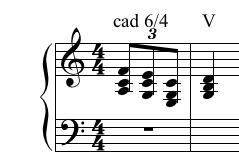
A deliberate, unassuming cliché. Where does it come from … ? Nowhere and everywhere. I wouldn’t even think about it, wouldn’t bother about it (in the same sense you wouldn’t analyze a comma), except that it seems to be a subject of contemplation in the song: the song ITSELF submits this cadence to analysis. It does this by toying with cadential possibilities. The example above is the “basic” version–ending in a root position V chord (G)–but Rufus colors it most of the time with the third below, E:
And some of the time he goes further, adding a more disturbing, questioning, intruding note (B-flat):
The E (voiced carefully down) simply makes the cadence somewhat “multivalent,” softens its too-classical tonality. But if this E is a “coloration” of the dominant, the B-flat feels more like a “contradiction.” In music theory terms, the B-flat heads us in the other (the wrong?) direction, back towards the subdominant …
So, Rufus is toying with options, with shadings of this cadence–and the music keeps coming back to this incomplete cadence, almost irritatingly. (No matter what). Again and again starting tonic, going to dominant; each phrase a question, never really answered. No corresponding, replying phrase: no “consequent.”
It is in this consequent-free context that my magical moment appears. Towards the end of Memphis Skyline, the piano is ruminating (obsessively) over this same cadence. We hear it three times in a row! (The cadence is now isolated, seprated from the phrase, understood as “the point”). The first two times, the E is present, the B-flat is played; an impasse; an unanswerable contradiction; let’s try again. But the third time, the piano plays a conventional V, a good old-fashioned V-7, actually… sounds almost hymnic, barbershop quartet? … perhaps it will simply resolve, finally, this cadence, this obsession?
But Rufus, so close to the ground, seizes this opportunity to take off, to make a visit to an implication: the B-flat, that “contradiction.”
So, when this B-flat is heard a third time, it is not an accident, not a “wrong note” (though it has posed as one). Rufus, inspired by it, enters a third above this B-flat (“So … “), on a D; a high F tremolo is heard. Voila! A harmony: B-flat; D; F. Are we in “pure” B-flat major, is this what the B-flat has “meant” all this time?
Before answering that question, obliquely, another: If you were going to set those lines (“so kiss me my darling, stay with me till morning”), give them a melodic contour, would it be this?:
This is Rufus’ setting. (I have flattened out the rhythmic relationships to make a point). It seems like the setting of an idiot, someone with only three notes on his electronic keyboard. These (E, D, C) are “cadential” melodic notes … (Three Blind Mice, Lebewohl, Schenkerian 3-line) falling, relinquishing, and if only Rufus could settle on C, it could end, the tension could be resolved… but you can see that he keeps going over the three notes, reiterating the obvious. The texture explodes into shimmering, quiet, pulsing arpeggios. The whole purpose of this passage is to introduce a shifting cast of characters beneath these familiar notes (to think over the cadence!). Rufus visits upon these basic, relinquishing tones (E-D-C) a tremendous amount of expressive resistance. The melody’s desire to resolve (leave, depart, be finished, pass away) vs. the harmony’s desire to prolong? (“Stay with me till morning.”) And so each go-around has a different harmonic connotation… first D-C (“kiss me”):
Then back through E-D-C with an especially long wait on the beautifully harmonized D:
Then my favorite! He takes another spin through the 3 notes, with a fantastically unexpected bassline. Rufus must love this one too because the bass slides down from A to D, calling attention to itself. I always feel a little desire to jump around, to make some frenetic movement at this moment, because there is this supercharged static electricity for me here, some sense of repressed force:
And one last, incomplete, version… E E D … (where’s my C?)…
Don’t forget that that dominant cadence (from before we ever got into this beautiful mess) is still waiting to be resolved. Rufus has not forgotten. With that B-flat excursion, he merely wanted to make us forget; so we can be made to remember. He was written a purple patch. And on this last D (“-ning”) he seems to notice at once that the dominant’s time has come (though of course he has prepared it inexorably), and to want moreover to make the “simple dominant” as thrilling as all the rest has been. Wonderful, ranging scales in the bass, unexpected voicings, permutations of the dominant, the dominant is alive! And no simple ending either. At the moment of resolution, while the strings are still holding a suspension (C), a “wrong-note/right-note”, a muted trumpet enters with B. B and C blur against each other: another contradicted cadence.
I was on the phone with a good friend who told me, if I “ever ran into Rufus,” to tell him that the sucking, breathing sounds he makes between phrases in the live recordings are “very distracting.” Hopefully I will “run into” Rufus someday, if only to tell him how much I have enjoyed even just thinking about this one passage, but I will not pass on my friend’s advice. I sympathize with those sounds. If you have a simple melody note to sing, over complicated harmonies, there is a gap of meaning which you are dying to fill. I often take complicated breaths before simple notes at the piano, trying to put as much meaning into my little E or D or C as I can, as much as I feel is in there. It is never enough, and my moaning and gesturing and whatever body language I bring to the piano will never be enough either. But: the gap is thrilling. I am glad Rufus (someone out there!) is writing melody notes that have so much to yearn for, that are so incomplete. Listening to this acoustic desire, I wallow in my own desires and let them carry me to elation or melancholy, by turns. Isn’t that puppy love? QED.

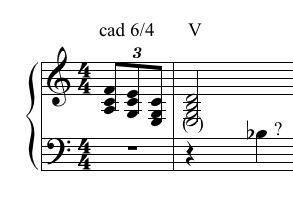
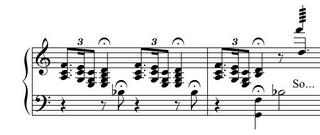

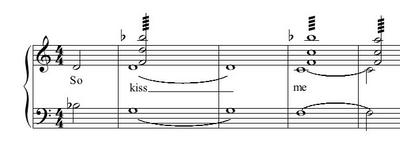
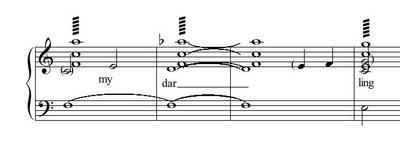

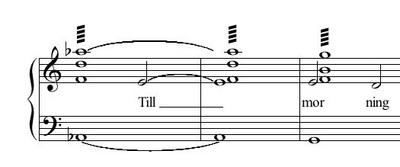

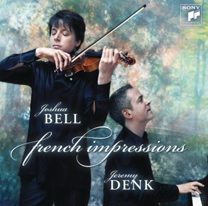

6 Comments
jeremy–
i very much enjoy reading your blog. as far as your reading of the rufus tune is concerned, may i suggest that if you like what you hear on “want two”, which is arguably his least successful disc, that you go check out his eponymously titled record? it’s wicked beautiful, and the songwriting is stunning.
oh, and for god’s sake, return alisa’s call! (weilerstein, that is)
and finally, i would just call the G over E an e minor 7, but that’s mere pop/jazz theory…
See http://TheFuturum.com – you can send message to eternity there.
Rufus has done well with deceptively accessible harmony. This passage is definitely a highlight, as he slows down the progression of the song to a deep burn and turns the screw of intimated dissonance to paint his expression of appreciation for Jeff Buckley. There are moments of Buckley’s music that are comparable, and far as tone coloring – for example, the progression of 9th and 11th chords in “Lover” – and Rufus not only honors that, but in his own unique and affecting way. Great going, boys.
While we’re “outing” ourselves, I must confess that I listen to much more pop and jazz than I do classical music, and I don’t care for much “contemporary classical” – or whatever you want to call it – at all.
Right now I’m addicted to Pat Metheny’s “One Quiet Night” CD of solo guitar music. He plays a Linda Manzer baritone guitar (Tuned to A below the E of a standard axe), and it’s hauntingly beautiful. He uses a modified Nashville tuning with the G and C strings strung up an octave, so the chord voicings he gets are other-worldly. I like it so much, I bought the music and fully intend to study the heck out of it.
As a neo-classical guy who comes from a jazz background, I feel like I have more in common with him (And, Pat is an old aquaintance of mine) than with any of the contemporary classical guys, who mostly write stuff I find ugly and uninteresting.
Cliche’s are good: I use a i, iv, bVII, bIII, bVI/Fr.+6, V(m9) in a guitar sonata of mine. I’d probably be laughed out of a university music department for that, but it’s PRETTY, and I LIKE IT. So, nanny, nanny, boo-boo. ;^)
Bubs,
Was just thinking about you and could not resist the “puppy love” title – all of which has led to a bizarre coincidence. I have recently managed to extricate Rufus’ Poses disc from Heather’s car, where it has no doubt languished nearly unused for the last two months. I purchased it as an anniversary present for my darling wife, but Maya will not let Rufus be heard when the Muppets are available.
In any case, since locating the disc and spending ample time with it on long drives around our lovely rural corner of creation, I have been unable to once again extricate it from my CD player. It has been this very fact that has led me to think about how you are – the New York connection, perhaps, or the pianist’s secret bond that leads you on literary flights of fancy and leads Rufus to reference Thomas Mann in his work.
I have been tired and hope we will see you for Christmas, at which point I would gladly lend you Poses if you are interested. I may be finished with it by then. If you want the Muppets, you’ll have to wrestle Maya for it.
Jeremy
Wonderful analysis! I appreciated your comments on my Rufus blog http://rogerbourland.com/wainwright and would love to deputize, or beg you to help me out on my more musical posts. I have Rufus fans helping me with some of my questions, but need smart musicians like you! You can email me by putting an at between my first and last name. List my blog if you will! My posts this week are more autobiographical, so amuse yourself if you’d like, otherwise, search out the categories that describe your expertise best.
Best, Roger